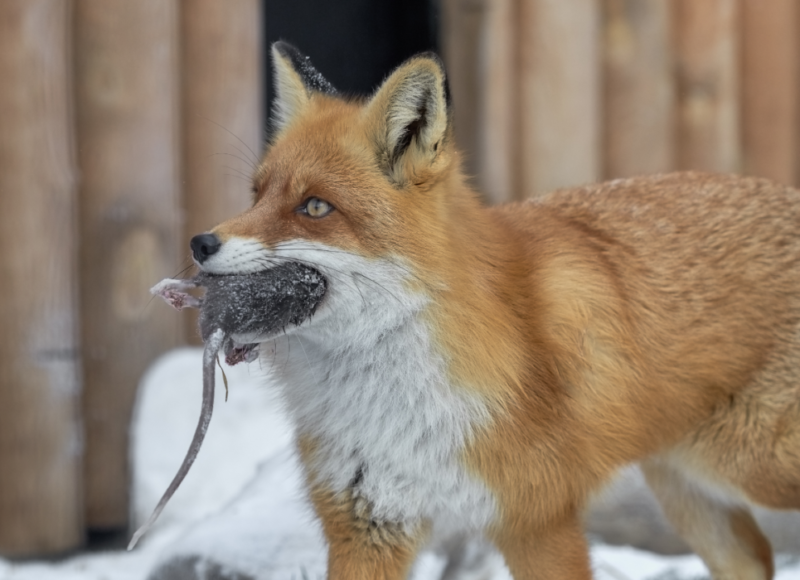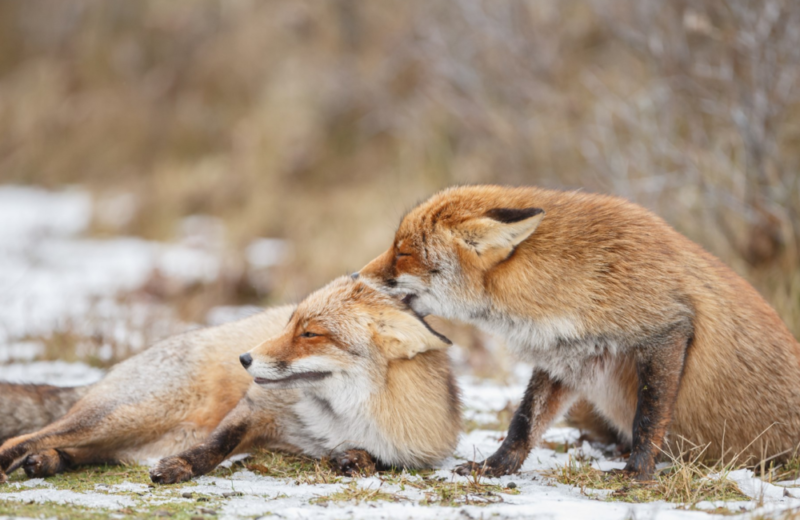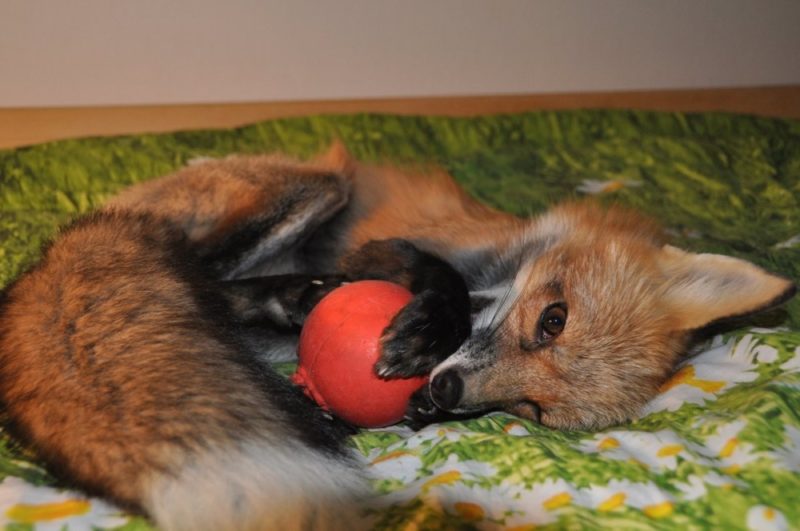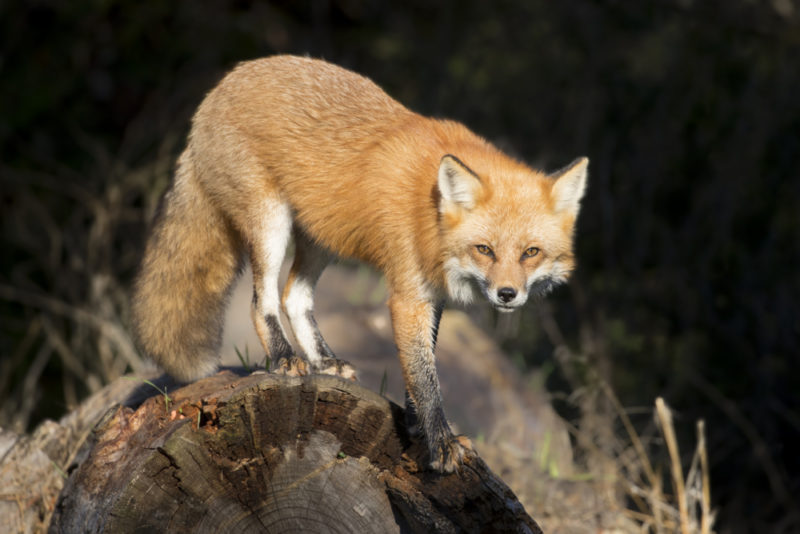The ordinary fox (Vulpes vulpes) is a predator belonging to the Canidae family. Representatives of this species can be found in almost every region of Russia. And also foxes are widespread in most countries and continents - such a wide habitat is due to the fox's exceptional ability to adapt and adapt.
Material Content:
Description of the appearance of an ordinary fox
The appearance of the fox may vary depending on the region of habitat. More than forty subspecies stand out, the appearance of which may have its own specifics.
The north the animal’s habitat is located, the larger and lighter the color. It is in the northern and mountainous regions that one can meet foxes of rare colors: black-brown and silver. Northern foxes are characterized by melanism (coat color in dark colors).
The most common color scheme: the back, head and upper part of the withers are bright red, the breast, belly and tip of the tail are white, the paws and the back of the ears are dark brown or black.
General description of the species: the body size of the fox is medium, from 60 to 90 centimeters, with 40% of the long and very fluffy tail. Its length reaches 50 centimeters. Body weight is 6-10 kilograms.
The fox looks typical of most other animals of the Canine family: an elongated muzzle, ears of a locator type that allow you to hear well at a great distance, neat thin legs, a very large tail, covered with dense fluffy fur.By the way, the large size of the tail is of practical importance: it allows you to better control speed and balance during fast runs, and also helps to warm up in the cold season.
In winter, the fox is very beautiful - by December grows warm winter fur, longer and thicker. This hairline allows you to survive the cold months, even in the most severe conditions. By mid-spring, the time for molting comes, which ends in the summer.
Features and habitat
The range of the fox is very widespread: representatives of this species are found almost throughout the entire European territory, in North America, Africa and Asia. After the foxes were brought to Australia, they quickly adapted to the local climate, and now they can be found even on this remote continent.
The fox lives in all climatic zones: from the tundra to the steppes and highlands. The preferred habitat for this animal is forests, groves and copses, open areas with ravines, shelters and good vegetation cover. Less common are foxes in dense forests and regions where snowfalls last a very long time. Such conditions make it difficult to obtain food.
To equip a burrow, a predator usually chooses a hill or ravine in sandy soil near swamps and ponds. There she digs her own home or occupies the empty burrows of other animals. In some cases, the fox can settle in a suitable natural shelter: for example, in a cave or an empty tree trunk.
With the development of civilization and an increase in the number of human settlements in the immediate vicinity of natural objects, foxes began to actively settle at a small distance from people. Predators are engaged in the extraction of food in urban and village landfills and equip their homes in the basements of houses and in the foundation niches.
Character and lifestyle
The red fox is most active in the dark. There are exceptions, but they are not so common. Fox vision is well adapted for night vision, however, during hunting these animals usually rely on hearing and sense of smell.
The hunting process itself is as follows: as soon as the fox hears the sound made by the mouse or other small animals, it abruptly freezes and calculates where the prey can be. After that, she makes a quick and sharp jump in the right direction and presses the victim with her paws to the ground. It is very funny to watch the winter mocking of a fox when a predator dives behind rodents in snowdrifts.
The territory of the foxes is marked by their excrement, and usually they do not go far beyond the designated area, provided that there is enough food. When an animal notices the invasion of other foxes on its territory - the matter is decided by a fight.
These animals are extremely curious - almost anything can attract their attention. Because of this, the fur-bearing animal often suffers - meetings with trains and cars lead to severe injuries, the sound of which does not scare the fox, but only causes interest. Attempts to eat trash left by a person can result in serious illness and even death. It must be remembered that after going to the forest, thorough cleaning of the territory is required - even one plastic bag can be a danger to wild animals.
Foxes live in burrows, which usually dig on the hillsides. When arranging, usually a lot of intricate moves erupt with several exits to the surface - this is done for security purposes. Usually, a fox hole is used not as a permanent shelter, but as a refuge, where the beast is going through hard times, gives birth and nurses foxes or hides from enemies.
In winter, the red predator does not hibernate - it walks through its territory in search of food.
Fox diet
The fox is a predatory mammal. The basis of her diet is mice and other small rodents.
The narrow fox face and neat thin teeth are adapted for hunting them.
In winter and during the period of feeding offspring, the fox preys not only on mice, but also on larger animals, as well as birds.
A tendency of foxes to omnivorousness is noted: these animals can eat not only the meat of rodents caught in the hunt, but also do not disdain vegetables and fruits, food waste that people throw out, and in the most hungry times they dig earthworms. Many foxes are happy to fish.
Predators living near rural areas can attack domestic chickens and small animals, which is why some consider foxes to be pests. But it is worth noting that the fox almost always opts for weak and unadaptable birds. Many farmers believe that a small number of foxes living near the farm can benefit from the extermination of rodents that destroy crops.
Mating season and reproduction of the animal
The beginning of the breeding season occurs at the end of winter or the beginning of spring - usually this occurs in March. Several males are fighting for the attention of one female at once, who are all the time from her in close proximity and arrange fights, ending with the victory of the most powerful animal.
The average number of foxes in the litter of the common fox reaches 4–6, but rare births of up to 13 puppies are known. Pregnancy lasts a little less than two months: usually up to 53-56 days. Closer to childbirth, the animal takes refuge in the distant passages of a hole that is best protected from any external threat.
Newborn foxes are covered with rough brown hair, they are blind and deaf. From the moment of birth to the first birth of a burrow, up to 20 days pass. The period of feeding breast milk lasts up to one and a half months. As soon as it becomes difficult to feed the younger generation, parents begin to learn to hunt foxes.
Curious babies are taken a certain distance from the hole and taught to catch various animals, usually large insects: locusts, grasshoppers, crickets.
Usually, by the end of summer, animals are already quite well developed and are able to prey on their own. They reach puberty in 1 year.
Natural enemies
The life expectancy of an ordinary fox in natural conditions is about 7-9 years, and in captivity it can reach 20. This is due to the fact that in natural conditions a fox has a large number of enemies. Despite the fact that this cunning animal has well-developed survival skills, it still remains a welcome prey for many predators.
The threat to individuals is:
- Large predators are wolverines, forest wolves, brown bears.
- Birds of prey - eagles, golden eagles, hawks and others.
- Parasites are ticks and fleas that transmit deadly diseases.
- Large foxes of other species, for example, corsac.
- Man - foxes are often hunted for their fur, especially greatly reduces the number of individuals in the population of poaching.
Most of these animals are neighbors of foxes in the middle lane. The inhabitants of America or Australia do not observe such a number of enemies, however, there the population is regulated by other factors, such as a small amount of food.
Enemies can be dangerous not only direct, but also indirect. So, wolves very rarely choose foxes as an object of hunting, but they feed on the same medium-sized animals, thereby reducing the amount of food. This is especially harmful in the cold season, as well as in periods of severe drought, when predators have to seriously compete with each other.
A threat to foxes living in the immediate vicinity of humans is provided by packs of stray dogs, which in case of starvation actively hunt forest animals moving closer to cities.
Domestication of a predator
Domestication of wild foxes began recently - a little over half a century ago.In 1959, the Novosibirsk scientist Dmitry Belyaev and his colleagues selected a group of individuals that behave most loyally to humans, as a result of which animals that were similar in behavior to domestic dogs were bred.
The original goal of the experiment was to study the process of taming our wolf ancestors.
As a result, we got unique animals that are completely not afraid of humans, these foxes are playful and obedient, they themselves meet, they love affection and tactile contact.
It was noted that in the process of domestication, animals began to change their appearance: the color underwent changes, a lot of white spots appeared on the hair, in some individuals the tail curled with a ringlet. According to scientists, changes in the body of foxes occur at the genetic level. Thanks to modern scientific methods, the thousand-year evolutionary path of the fox has passed over several decades.
As a result of actions to tame foxes, it became possible to train training programs, they are in good contact with people and can live along with dogs in ordinary city apartments.
Most foxes adapted to live with humans now live in a research center under the close supervision and care of followers of a famous geneticist, some have already moved to their new owners. The sale of foxes as pets is gradually being established - animals are specially prepared for transportation to a new house and must be sterilized.
The fur animals rescue movement is also gaining popularity. Its participants buy foxes on farms where animals are raised for fur production. Such animals are much less adapted, but quite successfully live in suitable conditions, when they are provided with spacious aviaries and a large amount of living space.
In captivity, the fox's life expectancy is much higher; with proper care, it is able to live for almost a quarter of a century.
Fox fur value
Farmers grow foxes to sell fur for winter clothing. Fur fur coats have average wear parameters: from 6 to 8 seasons (for comparison, otter fur can be worn for up to 20 seasons without repair).
Products made of fox fur are light and hold heat well. They can be called really valuable for residents of the northern regions with harsh winter conditions, when clothing made of artificial material does not save from the cold.
The population is greatly harmed due to hunting: for example, the famous black-brown foxes are now threatened with extinction and are listed in the Red Book. Many animals suffer at the hands of poachers.




















